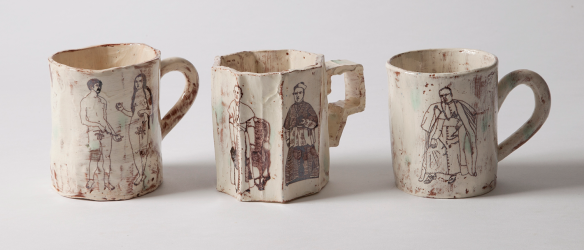 Hand made earthenware mugs with oxide transfers
Hand made earthenware mugs with oxide transfers
av. ht. 11cms
All photographs: Oliver Eglin
Essay for Phil’s show at The Scottish Gallery, 3 August – 2 September 2017. It marks the 175th anniversary of the Gallery and coincides with The Edinburgh Festival.
View the show and catalogue here:
https://scottish-gallery.co.uk/exhibitions/unfinished-business
Phil Eglin sometimes goes to the considerable trouble of making a mould in order to use it only once. This is inherently contradictory: mould-making implies near-identical reproduction, but Phil’s interventions make each piece unique. It’s as much about what is pressed into the plaster mould, which leaves a specific mark. He can make things differently every time: part-pressed, part-hand built – sometimes taken out of the mould in a soft state and manipulated.
There is an edge, a contradiction, in everything Phil does; a kind of binary tension which gives his work both appeal and intellectual heft. He understands so well the human body and its beauty and formal vulnerabilities, and is a superb draughtsman, yet oftentimes he rejects this ease of his own understanding in favour of naïve drawings by his own children or from primary school workshops. And yet again, his own drawing retains that same direct, elemental description, without mannerism or styling.
He borrows text too, which he incorporates into the work; with the same principle of separation from his own hand – from graffiti, from hoardings; from found texts submitted by friends. A friend’s young daughter writes titles for him. Nothing if not a pragmatist.
The text and decoration has a formal function, useful on the ‘flatback’ figures he has been making since his student days at the Royal College of Art, to make the viewer move. This is particularly pertinent on the ‘bucket’ works which carry disconnected imagery and themes on one side and another, and on their interior and exterior faces. One has a figure from an early Delft tile, emulating its economy of blue line and stylised rendering of costume and profile. Each piece speaks in many tongues, the language of one era of drawing juxtaposed with the high decoration of another; bold pink chevrons borrowed from a Gucci dress in a 2016 Glen Luchford promotional video. He even renders the marks of ageing from original observation of antique works, painstakingly evoking the crazing and fractured edges of the Delft tile.
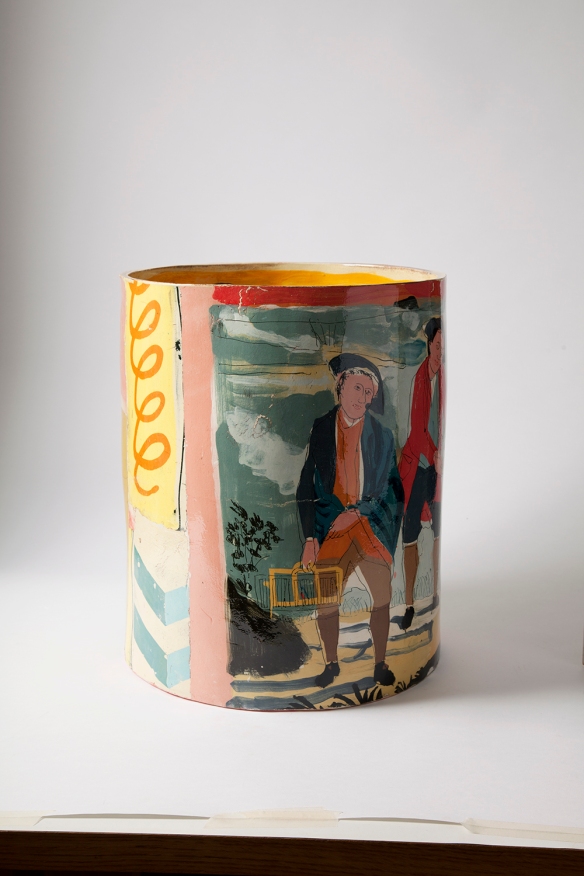
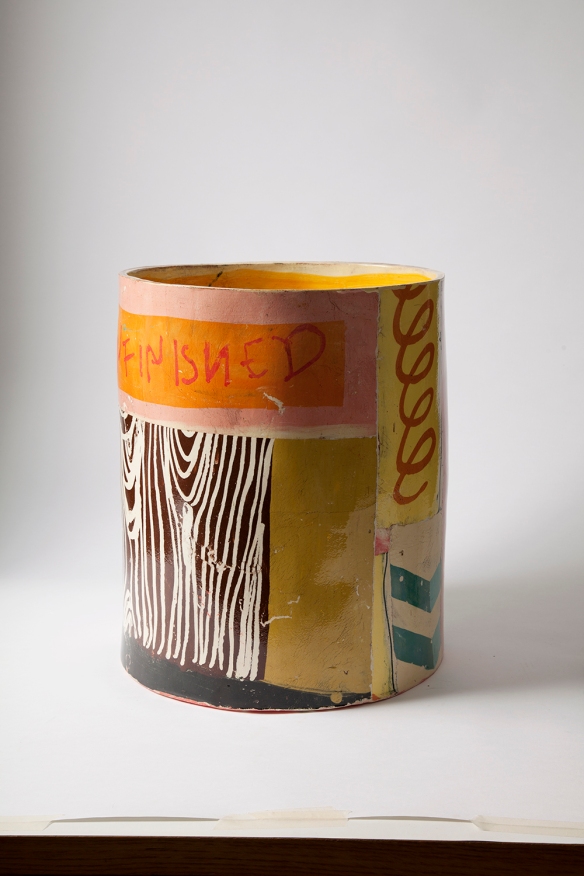
He is a consummate technical potter: with a huge technical vocabulary, he switches, borrows, combines recognisable idioms, from hand-built figures to the simplest, over-scaled cylinders which allow the greatest surface area for the application of motif. He has mastered hand-building, press-moulding, slip-trailing and glazing techniques over several decades of consistent practice. But he rejects the easy facility of that expertise: he always throws grist in the mill, injects an element of awkwardness to retain the sharpness of the practice. Happy to riff on connections and contradictions between techniques normally distinct, this is characteristic of his general approach to life and to work.
Any Phil Eglin exhibition acts as a kind of retrospective, in that he revisits themes and concerns he has worked on over the years, rich with possibility: ‘Popes, Priests and Prostitutes Pinups’. He says, why shouldn’t I revisit a subject? But his work always reflects where he is right now, a man at this stage in his life: it’s about the self, referencing the family, recent news items like Operation Yew-tree, and the scandals of exploitation within the Catholic Church. His grown-up sons feed him word of what is out there in the world, and he feeds the information back into his imagery. He is well-read and an accomplished researcher, spending long hours drawing from the notable ceramic collections in Aberystwyth and Glynn Vivian in Swansea.
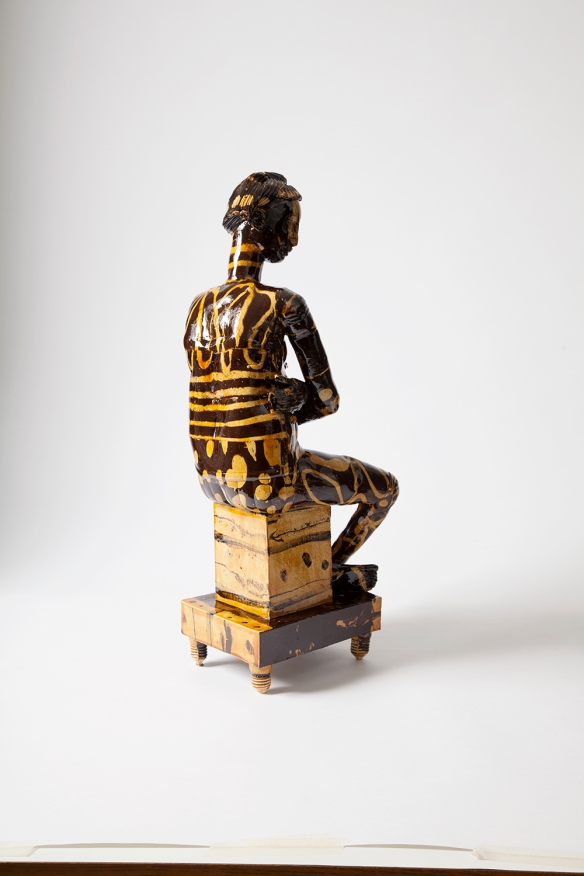
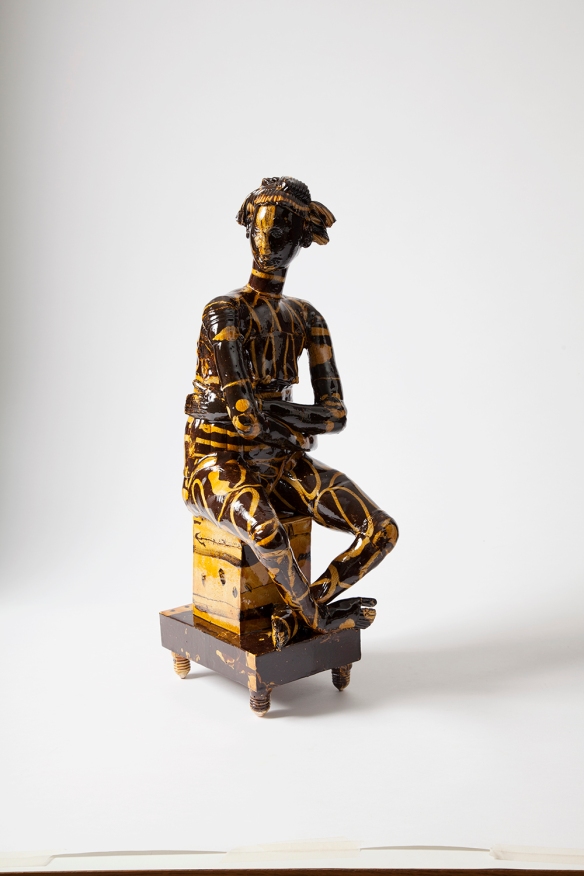
There are historical precedents for the things he is making: Victorian flat-back figurines, figures in Cranach paintings from the 15th C; late-18th C Ralph Wood figures (pressed ceramic, lead-glazed figures where the seams are exposed). A series of ‘artist and model’ works occupies a long tradition of the double portrait in this mode – back to Picasso and earlier masters. There are now of course modern sensibilities applied to these dual images: ones of equality; of balance of power; the clothed figure versus the nude figure; of the ‘male gaze’. Phil is sensible to these new pressures, of political correctness, of hierarchy, of the acceptability of the genre.
He has works in significant collections all over the world. He is thus able to make really substantial works with a realistic expectation of placing them well. But he also makes very small works, and transfer work on plates, because it has an immediacy which allows him the satisfactions of fairly rapid results. He says it is akin to channel-hopping; learning through making, without huge commitment, a nimble process of idea-acquisition and experiment. Immediacy.
Unfinished Business implies irresolution, but is really an acknowledgement of the ongoing narratives running through Eglin’s work, in themes, in techniques, in places and pieces revisited and revived through sharp scrutiny. In terms of subject-matter he has always been subversive, accommodating the historic and the highly topical. He works up modern abstracts; derives imagery from images of ebay finds spoiled by the vendor in order to prevent digital copying – such as veteran photographs reproduced with Sharpie legends scrawled across them, or dotted with overlaid arrows or jarring motifs; Victorian erotic photographs of women disporting themselves on chairs, with overlaid symbols covering saucy parts; or historical imagery overlaid with texts and patterns with the frisson of post- post-punk. And thus he makes them even edgier. Somehow, none of it jars historically; in coming back to classical themes, he always comes back to the now, the highly pertinent: themes which are enduring and ultimately timeless.
Angry once – but calmer, if not mellower, now – he still feels the rawness, a lingering resentment at the Catholic Church’s own institutional whitewashing. In reworking the Madonna or the Christ-figure, say, there is a given narrative, and he can treat it with reverence or irreverence, sometimes a highly challenging combination of both. A lighter, brighter outlook – a celebration of the freedom and space of his new rural existence, perhaps – may have lent his work a new theatricality and enhanced desirability, but he has lost none of the immediacy or freshness of his contradictory edge.
Sara Roberts June 2017
